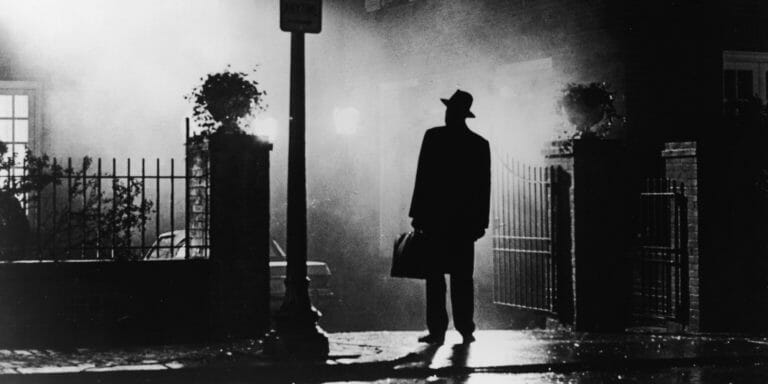Sign up for the
TSL Newsletter
and get $50 off Final Draft 12
By Ben Larned · April 18, 2017

In a culture oversaturated by grotesque images, whether on the news or in fiction, it’s hard to recall the origins of horror as a genre. Ancient legends and cautionary tales were spun in an attempt to explain the unknown, and warn people against falling into danger. Whether it’s a Grimm fairy tale or the Bible, a way of controlling behavior by threatening eternal torture, much of early literature is horrific. These centuries-old examples speak to a far different brand of terror than much of what we see today. They’re primordial, deeply rooted in entire worlds of myth. There are few cinematic examples of horror that reach the kind of dread that embeds in one’s soul.
Then there’s The Exorcist, a film rumored to have sent people screaming from the auditorium. Perhaps it caused such an uproar partially because its horror stems from popular religion. Unlike many horror films, it isn’t designed to scare, startle, thrill, then release; it’s depicting a possession as if it was really happening. There are parallels to “actual” cases of possession: the scratching in the attic, Regan using a Ouija board, then the eventual foul language and bodily harm. The presence of the Catholic Church, whose iconography is plastered over so many horror films, gives this story a heavy weight. Had Blatty gone for sensation rather than realism, the religious elements would have simply felt melodramatic. Because his novel and script both root themselves in actual cases and church protocol, the film takes on a sheen of reality that makes it far more chilling.

Modern audiences seem to have trouble accepting The Exorcist as a serious film. Young people, people my age, often laugh at Regan’s foul language, if they can get through the slow first half at all. Religion has certainly lost its weight in the cultural psyche; but stories of possession are more popular than ever. Many resort to elaborate prosthetics, overwhelming sound design, and visual effects to portray demonic spirits. Blatty and Friedkin may not have had access to these technologies, but that is all the better. Their film, which has influenced the possession genre completely, is one of the few that remains viscerally upsetting. Regan’s affliction is shown with the frankness of a bad disease. It’s all practical, all drawn from actual cases.

One of the few modern films that I’ve seen that managed to reach these heights of religious terror is The Wailing, a Korean masterpiece that without doubt takes cues from The Exorcist. A kind of hybrid that imagines Father Merrin entering Twin Peaks, the film follows a hapless detective investigating a series of murders caused by regular people – infected with a sort of demonic disease. When his daughter catches it, he scrambles for answers, and soon finds himself up against monstrous spiritual forces. Hong-jin Na fills his frames with flamboyant exorcisms, truly chilling displays of the possessed, and a sense of nihilistic doom that only thickens as the plot goes on. Like The Exorcist, the approach to the horror is purely cinematic – there are no funhouse tricks. The result is a story that feels pastoral, until suddenly it’s spiritual, but we’re on the wrong side of the afterlife here. This is a one-way trip to Hell.

Of course, these two films are not the only works to express pure folklore in cinema. A prime, less brutal example can be found in the eerily beautiful Kwaidan – an anthology that translates to “Ghost Story” – derives its four stories from Japanese legends, dating back several centuries. The stories have a timeless quality to them, and the painterly visuals lend the film an operatic quality, as if one is watching ancient history. The film’s epic, large-scale imagery evoke a mythic sense of dread. The stories feature several elements that match up with Japanese folklore: memories that come back to haunt or inhuman forces that can fall in love. Kuroneko also evokes classical mythology through its visual language. Its specters, two brutalized women who kill samurai for revenge, fade in and out of view, hurtling through dark spaces and trailing white silk behind them – their appearances are both chilling and beautiful. Their ghostly realm is a metaphysical trap for their prey, a mental spider’s web.

What distinguishes these efforts from other horror films? To me, it’s their attention to mythological detail – they research their source material thoroughly, and evoke it on screen in a matter-of-fact way, rather than dressing it up in theatrical tricks. Kuroneko and Kwaidan both utilize stunning in-camera effects, while The Wailing and The Exorcist display insane, terrifying makeup work – but these spectacles are only employed to fully bring the supernatural onto the screen. They aren’t trying to shock, they’re trying to invoke. And when one watches these films late at night, that is exactly what they do. Viewing The Wailing alone after dark, I had the absurd urge to look under the bed, just to make sure a demon hadn’t sprouted there. It’s no wonder religious viewers of The Exorcist fled in terror – they might have been worried that the demon would find them next.